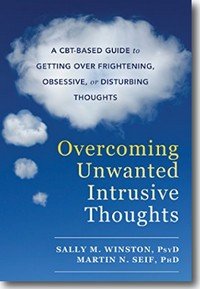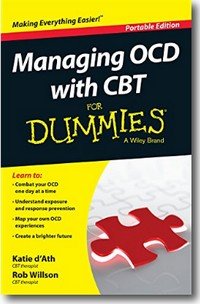Treating OCD with CBT?
|
 According to Lata K. McGinn, PhD, Cognitive Behavior Therapists (CBT) use systematic strategies to implement change following the development of idiographic case formulations, and are based on cognitive and behavioral models of psychopathology.1 Although structured assessments are used to diagnose conditions, assess severity of illness, and guide treatment planning, CBT therapists largely rely on conducting analyses of specific episodes of distress or problematic thoughts and behaviors to help establish how symptoms and problem thoughts and behaviors are linked, to understand the function they serve for the individual, and to determine which symptoms, thoughts, and behaviors should become the primary targets of treatment.
According to Lata K. McGinn, PhD, Cognitive Behavior Therapists (CBT) use systematic strategies to implement change following the development of idiographic case formulations, and are based on cognitive and behavioral models of psychopathology.1 Although structured assessments are used to diagnose conditions, assess severity of illness, and guide treatment planning, CBT therapists largely rely on conducting analyses of specific episodes of distress or problematic thoughts and behaviors to help establish how symptoms and problem thoughts and behaviors are linked, to understand the function they serve for the individual, and to determine which symptoms, thoughts, and behaviors should become the primary targets of treatment.
![]() Case conceptualizations are based on these functional chain analyses, and treatment strategies are systematically implemented to address targeted specific episodes of distress or problematic thoughts and behaviors as they and when they occur in the patient’s daily life. Global improvement in symptoms and functioning is seen as resulting from a process of generalization of multiple efforts at making such moment-to-moment changes.
Case conceptualizations are based on these functional chain analyses, and treatment strategies are systematically implemented to address targeted specific episodes of distress or problematic thoughts and behaviors as they and when they occur in the patient’s daily life. Global improvement in symptoms and functioning is seen as resulting from a process of generalization of multiple efforts at making such moment-to-moment changes.
Cognitive Models and Treatment
Cognitive models propose that emotional disorders, including obsessive-compulsive disorder (OCD), are characterized by maladaptive cognitive styles.2 The most comprehensive cognitive model of OCD to date suggests that obsessional thoughts are normal, but that individuals with OCD experience secondary automatic thoughts that arouse anxiety and result in the performance of both passive and active (compulsive rituals) avoidance behaviors in order to alleviate anxiety.
These automatic thoughts are hypothesized to represent dysfunctional assumptions and beliefs such as a sense of inflated responsibility for negative outcomes, an exaggerated sense of being vulnerable to harm, and an underestimation of their ability to cope with negative outcomes.
Individuals with OCD are consumed with doubt and uncertainty and find it difficult to endure their doubt and uncertainty. They tend to have magical thoughts, often fusing thoughts and actions, are extremely perfectionist and rigid in their thinking, place a high degree of over-importance on their thoughts, and attempt to have absolute control over their thoughts.
Cognitive therapists help patients accept symptoms of OCD as part of their illness and guide them to realize that obsessional content is irrelevant, is not predictive of future events, does not reflect poorly on their character, and that their attempts to stop their obsessional thoughts are not only unsuccessful, but can backfire by making those thoughts increase in frequency.
The cognitive therapist uses behavioral experiments to direct the patients’ attention towards obsessive thoughts and asks them to let their obsessions flow in and out naturally without trying to suppress them or to do anything to “undo” them. Patients learn that they can tolerate their anxiety, that their worst fears are unfounded, and that their obsessive thoughts reduce in frequency once they give up attempts to stop or to control them.
Using a process of guided discovery and Socratic questioning, the cognitive therapist also helps them identify and modify the degree to which they uncritically believe the content of their secondary automatic thoughts. By decreasing the believability of their automatic thoughts and the dysfunctional assumptions and core beliefs on which they are based, cognitive therapy helps reduce the range of emotions observed in OCD such as anxiety, sadness, guilt, and shame.1 Cognitive strategies also reduce the individual’s urges to ritualize and prepare them to undergo exposure and response prevention.
 |
 |
 |
 |
 |
 |
 |
 |
Behavioral Model and Therapy
The behavioral model of psychopathology arises from learning theory and posits that obsessional fears and behaviors are learned through a process of classical conditioning and maintained via operant conditioning. Exposure therapy is intended to break previously formed associations between stimuli that have become conditioned to generate anxiety, while response prevention is intended to break previously formed associations between avoidance behaviors such as compulsive rituals and feelings of relief.
Once the patient is appropriately socialized to treatment, the therapist and patient create a graded hierarchy of specific obsessive fears and avoidance behaviors following which patients are required to systematically confront these graded stimuli in their imagination (imaginal exposure) and/or in reality (in vivo exposure).1 Although complete in-session habituation is not necessary, each exposure session is concluded when anxiety is considerably lower, when cognitions are disconfirmed, or when the urge to end the exposure session has subsided.
The therapist also helps the patient generate a graded list of avoidance behaviors, including compulsive rituals, and then proceeds to guide the patient to block them via response prevention. Although completely abstaining from rituals is the final goal, the therapist generally uses graded hierarchies to achieve this goal over time and may incorporate various habit prevention and behavior modification strategies to help facilitate the implementation of response prevention.
A number of studies have demonstrated that CBT is more effective than placebo and other psychotherapies for the treatment of OCD, is comparable to serotonergic medications, and may even be more effective than medication in some cases.18,19 A recent meta-analysis showed that CBT outperformed controls in all 16 studies used in the meta-analysis.20 However, many patients remain symptomatic after treatment, suggesting the need for continued research on improving efficacy of treatments.21
Although it is difficult to separate the effects of behavior therapy and cognitive therapy given that they contain similar components, exposure and response prevention (ERP) appear to be critical elements within CBT, with 55-75% of patients reporting sizable improvement and maintenance of gains following treatment. Given the vast number of studies demonstrating the efficacy of ERP, it continues to be the first-line CBT treatment for individuals with OCD.
However, studies supporting the efficacy of cognitive therapy have grown over the years and suggest that cognitive treatments are not only effective in improving symptoms and reducing emotional distress, but may also be effective in improving treatment adherence and reducing treatment drop-out. Although some studies shows that ERP outpaces cognitive treatments, others show that cognitive strategies may be equivalent in efficacy to behavioral strategies.”
Lata K. McGinn, PhD, is an associate professor of psychology at the Ferkauf Graduate School of Psychology, Yeshiva University, Albert Einstein College of Medicine, in The Bronx, New York.
Psychiatry Advisor
http://www.psychiatryadvisor.com
![]()
How useful was this post?
Click on a star to rate it!
Average rating 4 / 5. Vote count: 4
No votes so far! Be the first to rate this post.
Originally posted 2019-08-31 07:13:47.
Contact: Rex@REBTinfo.com
- Dr. Ellis speaks on accepting self and others. - Fri 26 Dec 25
- Disputing Overgeneralizations - Thu 25 Dec 25
Tags: anxiety, Lata K. McGinn, obsessive-compulsive disorder, OCD
Search this site
Sticky Posts
Regular Columns & Features
Categories
USEFUL LINKS
Amazon Associate Member
Rex Alexander and REBT Info are participants in the Amazon Services LLC Associates Program, an affiliate advertising program designed to provide a means for sites to earn advertising fees by advertising and linking to amazon.com.
Disclosure
When you buy items using the links on this website, we may get a small commission which keeps me in coffee, which keeps me working, which keeps me providing valuable content for you. Thank you for your continuing support of REBT Info.com. ~Rex
TOS / Terms of Service
Pretty basic stuff: No fussing, no fighting, no cussing, no spamming, no scamming, no blaming, no flaming, no hating, no bating, no trolling, no personal attacks. No pornography (Damn!). The Golden Rule applies. Focus on issues, ideas and principles rather than on personalities and you will fit right in. Please keep your contributions friendly and polite, treat your fellow members and readers with respect and all will be well.
All content and information submitted become the property of REBT Info (REBTinfo.com)
Privacy Policy
PRIVACY POLICY
We at REBT Info value your privacy. Your personal information is secure with us. Secure server software (SSL) encrypts all information you enter before it is sent to us, and all of the customer data we collect is protected against unauthorized access.
We WILL NOT sell, rent, distribute or otherwise share your personal information, including e-mail address, to or with anyone for any reason (except in the extremely rare, unlikely case of demands by duly authorized law enforcement acting strictly in accord with due process).
For more information, please read the long version
Copyright
Copyright © 2012-2025 by Rex Alexander dba REBT Info / http://REBTinfo.com.
All rights reserved. The content of this website or any portion thereof may not be reproduced or used in any manner whatsoever
without the express written permission of the publisher except for the use of brief quotations in a book review.Disclaimer
This website, REBTinfo.com, and others under the REBT Info family are for education, information and entertainment purposes only; are not intended as, nor should be regarded as medical or psychiatric diagnosis, advice or treatment.
By accessing this blog you understand and agree to these conditions, as well as to the other Terms of Service / TOS posted, and which may be updated and amended from time-to-time.
Agreement
By accessing this website blog and related media, you affirm that you have read, understand and agree to our Terms of Service / TOS which may be updated and amended from time-to-time.
This is a public blog
Anything you post may be viewed by the public. Therefore, do not post anything you wish to remain private.



